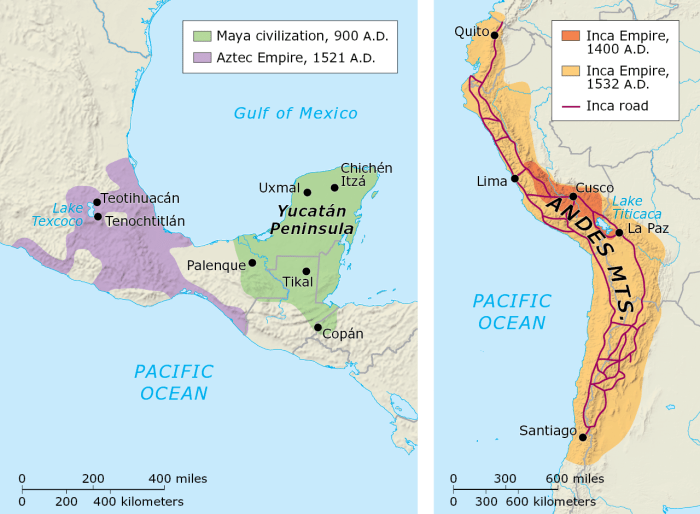Maya inca and aztec map – Embark on a captivating journey into the world of Maya, Inca, and Aztec maps, where ancient civilizations etched their understanding of the world onto parchment and stone. These intricate maps not only guided their people but also provide invaluable insights into their cultures, beliefs, and the landscapes they inhabited.
From the intricate codices of the Maya to the knotted quipus of the Inca and the monumental carvings of the Aztec, these maps reveal the ingenuity and artistry of these ancient civilizations.
Maya, Inca, and Aztec Maps
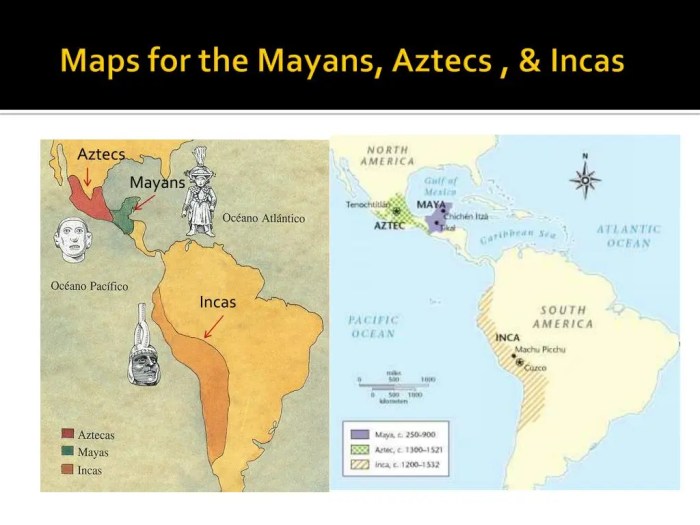
The Maya, Inca, and Aztec civilizations were all highly advanced cultures that flourished in the Americas before the arrival of Europeans. One of the most impressive achievements of these civilizations was their development of sophisticated mapping systems. These maps were used for a variety of purposes, including navigation, land management, and religious rituals.
Maya Maps
The Maya were one of the first civilizations to develop a written language, and they also developed a complex system of hieroglyphics. These hieroglyphics were used to create maps that recorded information about the Maya’s territory, including the location of cities, rivers, and mountains.
Maya maps were also used to track the movements of the stars and planets, and to predict eclipses and other astronomical events.
One of the most famous Maya maps is the Dresden Codex, which is a collection of hieroglyphic texts that includes a number of maps. The Dresden Codex is believed to have been created in the 13th century, and it provides a detailed look at the Maya world at that time.
The Maya, Inca, and Aztec maps were incredibly advanced for their time, demonstrating the sophisticated civilizations that created them. Like the intricate patterns woven into a king’s brass cobweb, a king for brass cobweb , these maps showcased the ingenuity and artistry of their creators.
The Maya, Inca, and Aztec maps continue to inspire awe and admiration, offering glimpses into the rich cultural heritage of these ancient civilizations.
Inca Maps, Maya inca and aztec map
The Inca were a powerful empire that ruled over a vast territory in South America. The Inca developed a system of roads and bridges that connected their empire, and they also created maps to help them navigate these roads. Inca maps were typically drawn on pieces of cloth or animal skins, and they used a variety of symbols to represent different features of the landscape.
One of the most famous Inca maps is the Huarochiri Codex, which is a collection of indigenous Peruvian texts that includes a number of maps. The Huarochiri Codex is believed to have been created in the 16th century, and it provides a detailed look at the Inca world at that time.
Aztec Maps
The Aztec were a powerful empire that ruled over a vast territory in Mesoamerica. The Aztec developed a system of canals and causeways that connected their capital city of Tenochtitlan to the surrounding area, and they also created maps to help them navigate these waterways.
Aztec maps were typically drawn on pieces of paper or bark, and they used a variety of symbols to represent different features of the landscape.
One of the most famous Aztec maps is the Codex Mendoza, which is a collection of Aztec hieroglyphics that includes a number of maps. The Codex Mendoza is believed to have been created in the 16th century, and it provides a detailed look at the Aztec world at that time.
Similarities and Differences between Maya, Inca, and Aztec Maps
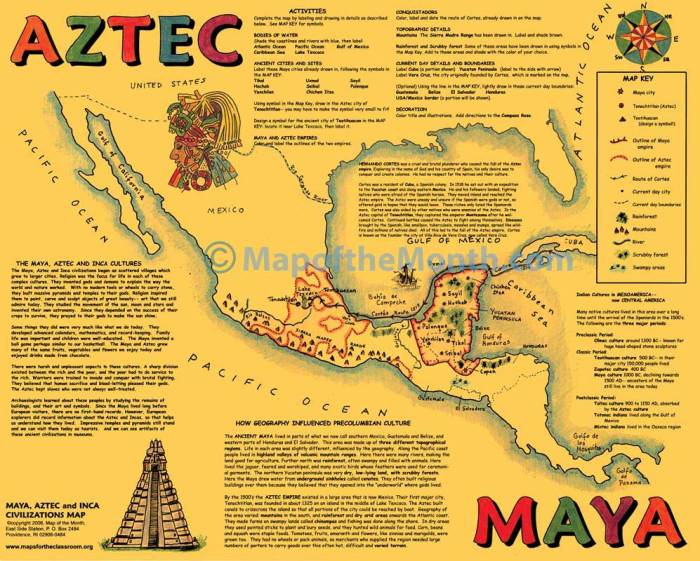
The Maya, Inca, and Aztec civilizations developed sophisticated map-making techniques that reflected their unique cultural and environmental contexts. Despite sharing some similarities, these maps exhibited distinct differences in their content, scale, and purpose.
Map-Making Techniques
- Maya:Created highly detailed maps on bark paper, using hieroglyphs and pictorial symbols to represent geographical features, settlements, and political boundaries.
- Inca:Produced large-scale maps known as “quipus,” which were knotted cords used to record distances, directions, and administrative information.
- Aztec:Created codices (illustrated manuscripts) that included maps, often accompanied by historical and mythological narratives.
Cultural and Environmental Influences
The differences in map-making techniques were influenced by several factors:
- Available Materials:The Maya used bark paper, while the Inca utilized knotted cords and the Aztecs had access to codices.
- Purpose:Maya maps were primarily used for religious and ceremonial purposes, while Inca maps were more practical for administrative and military planning. Aztec maps served multiple functions, including historical documentation.
- Geography:The Maya inhabited a dense rainforest, leading to the creation of detailed maps to navigate the terrain. The Inca’s vast empire required maps for communication and control, while the Aztecs’ lake-based settlement influenced their map-making style.
Comparative Table
| Characteristic | Maya | Inca | Aztec |
|---|---|---|---|
| Material | Bark paper | Knotted cords | Codices |
| Scale | Small-scale | Large-scale | Medium-scale |
| Purpose | Religious, ceremonial | Administrative, military | Historical, mythological |
| Content | Geographical features, settlements, political boundaries | Distances, directions, administrative information | Maps, historical narratives, mythological elements |
The Use of Maya, Inca, and Aztec Maps in Modern Research
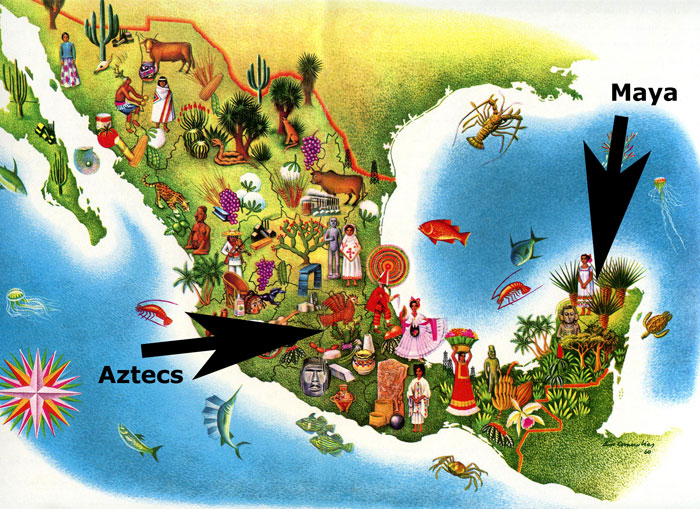
Maya, Inca, and Aztec maps have proven invaluable to modern researchers seeking to unravel the mysteries of these ancient civilizations. These maps provide a unique glimpse into the spatial organization, geographic knowledge, and cultural practices of these societies.
Challenges and Limitations
While Maya, Inca, and Aztec maps offer a wealth of information, their use as historical sources is not without challenges and limitations. Many of these maps were created for specific purposes, such as navigation or land ownership, and may not accurately reflect the entire landscape or cultural practices of the civilization.
Additionally, the survival of these maps is often fragmentary and incomplete, making it difficult to reconstruct a comprehensive picture of the ancient world. Despite these limitations, Maya, Inca, and Aztec maps have made significant contributions to our understanding of these ancient cultures.
Contributions to Understanding
Maya, Inca, and Aztec maps have provided insights into the following aspects of these civilizations:
- Spatial Organization:These maps reveal the layout of cities, towns, and agricultural areas, providing insights into the social and political organization of these societies.
- Geographic Knowledge:The maps demonstrate the sophisticated geographic knowledge of these civilizations, including their understanding of topography, water resources, and trade routes.
- Cultural Practices:Maps often depict religious sites, ceremonial centers, and other cultural landmarks, offering glimpses into the beliefs and practices of these ancient cultures.
For example, the Maya Codex Dresden contains a map of the Maya city of Tikal, which shows the layout of the city’s temples, palaces, and other structures. This map has been used by researchers to reconstruct the city’s history and understand its social and political organization.
The Legacy of Maya, Inca, and Aztec Maps: Maya Inca And Aztec Map
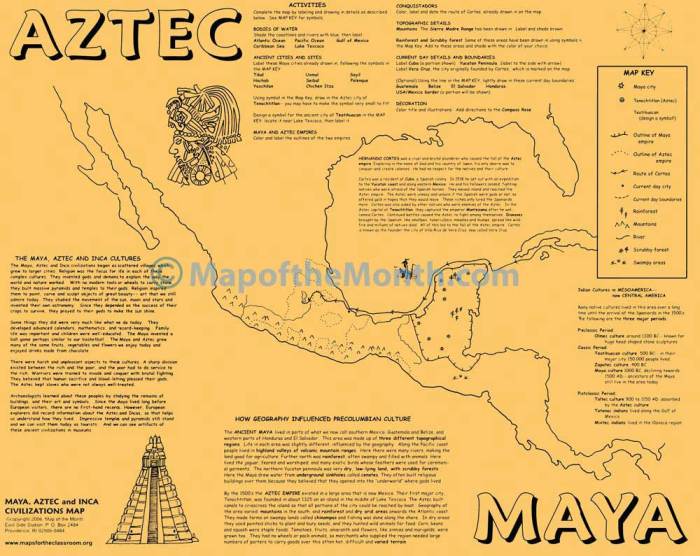
The Maya, Inca, and Aztec civilizations left behind a rich legacy of maps that continue to inspire and inform contemporary cartography and historical research. These maps, crafted with remarkable precision and artistry, provide invaluable insights into the cultural, political, and environmental landscapes of these ancient civilizations.
Enduring Legacy in Cartography
The maps of the Maya, Inca, and Aztecs have had a profound impact on the development of cartography. Their innovative use of grids, symbols, and color-coding laid the foundation for modern map-making techniques. The Maya’s use of a complex grid system, for instance, allowed them to create highly accurate representations of their territory.
The Inca’s use of quipus, knotted cords used for recording information, enabled them to create detailed maps that conveyed both geographic and statistical data.
Inspiration for Contemporary Map-Making
The maps of the Maya, Inca, and Aztecs continue to inspire contemporary map-makers. Their intricate designs, attention to detail, and use of non-Western perspectives challenge conventional cartographic practices. For example, the Maya’s use of multiple vantage points and the Inca’s incorporation of three-dimensional elements have influenced the development of modern 3D mapping techniques.
Timeline of Map-Making Evolution
- Maya (c. 300-900 CE):Developed complex grid systems and used hieroglyphs to record geographic information.
- Inca (c. 1400-1532 CE):Created detailed maps using quipus and three-dimensional models.
- Aztec (c. 1300-1521 CE):Produced highly stylized maps with symbolic representations of cities and landscapes.
- 16th Century:European explorers encounter Maya, Inca, and Aztec maps, influencing the development of Western cartography.
- 19th Century:Archaeological discoveries shed new light on the sophistication of ancient maps.
- 20th Century:Technological advancements, such as aerial photography and GIS, revolutionize map-making.
- Present Day:Maya, Inca, and Aztec maps continue to inspire and inform contemporary cartographic practices, including 3D mapping and participatory mapping.
FAQ Explained
What were the different types of maps created by the Maya, Inca, and Aztec civilizations?
The Maya created codices, painted manuscripts on bark paper, which included maps depicting their cities, territories, and religious beliefs. The Inca used quipus, knotted strings, to record numerical data, including distances and locations. The Aztec carved maps into stone, depicting their empire, cities, and waterways.
What was the purpose of these maps?
These maps served various purposes, including navigation, land management, religious rituals, and historical records.
How have Maya, Inca, and Aztec maps been used in modern research?
Modern researchers have used these maps to study the political organization, economic systems, and cultural practices of these ancient civilizations.
